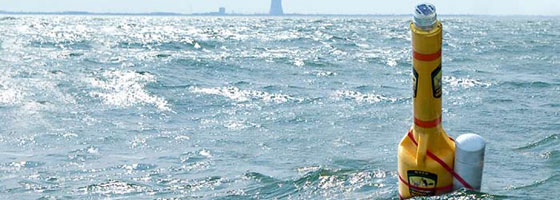Ohio Division of Wildlife Studies Lake Erie Walleye Hatch

Lake Erie is described by many as the “walleye capital of the world,” but populations of the fish might be dwindling in the area.
That’s a big deal for Great Lakes fishermen, who are a part of the region’s multi-billion-dollar commercial and recreational fishing industry that relies heavily on the walleye.
The last major walleye hatch in Lake Erie occurred in 2003. Hatch sizes since then have been, at best, below average. It’s unprecedented for a six-year period of substandard spawning; worse yet, many worry that walleye population in the lake has been on the decline since long before 2003.
There’s little doubt the issue stems from this inconsistent recruitment, which is the number of walleye added to the population from natural reproduction. But deciphering the intricate web of physical and chemical interactions that facilitate or hinder a good hatch is where it gets complicated.
Lake Erie’s nutrient cycles are certainly an important factor in walleye growth, and their timing is critical to producing the right type and amount of edible algae and zooplankton at the time the young walleye larvae need to feed on their own. Shifts in these cycles might be interfering with walleye reproductive success. Phosphorus and nitrogen feed excessive algal blooms, and an increasing amount of it is inedible toxic blue-green algae.
The ODNR’s Division of Wildlife Sandusky Fish Research Unit is exploring another angle — how walleye spawns are affected by lake currents. Aiding in the study is a newly deployed current-tracking data buoy, positioned proximate to the lake’s reefs where walleye breed.
The investigation, part of a multi-agency project, will further examine findings from research by Michael Jones at Michigan State University’s Department of Fisheries and Wildlife.
Jones’ research, which uses wind velocities over the lake to approximate lake currents, indicates that the success of a hatch seems to correspond with whether current is pushing toward or away from shore. This is largely because distance to shore dictates how warm the waters are, and temperature affects incubation and larvae growth, explains Fisheries Biologist Travis Hartman from the Sandusky Fish Research Unit.
“If you have an inshore current flow, the larvae end up in nearshore areas,” Hartman said. “These nursery areas are warmer and more hospitable to the young larvae, which potentially results in a larger hatch.”
If current has an offshore flow, on the other hand, the larvae tend to settle in cooler, less productive areas closer to the center of the western basin. These locations are less accommodating to emerging fry and support smaller hatches.
NexSens Technology was selected to assist in the design and configuration of the Lake Erie buoy monitoring system for the study.

Fisheries Biologist Travis Hartman works with a NexSens field engineer to mount an acoustic Doppler current meter.
The system utilizes an acoustic Doppler current meter that tracks water velocity in 3D. The current meter is mounted to an instrument sled at the lake’s bottom. Also attached to the sled is a multi-parameter water quality sonde with sensors for measuring temperature, conductivity, and dissolved oxygen, which Hartman said are all factors that can affect a hatch.
“We need to know more about warming rates, oxygen levels, and prevailing currents during the hatch,” Hartman said.
Cables connect the sonde and current meter to a NexSens submersible data logger that is mounted to the surface buoy. ODNR biologists periodically visit the site to offload data from the data logger. Future plans include implementing real-time cellular telemetry that will allow for review of the latest data without making a trip to the buoy.

Hartman readies the lake-bottom instrument sled for deployment.
The data buoy and attached lake-bottom sled are located west of Put-in-Bay and between the Niagara and Crib reefs. Walleye breed on the reefs, which are shallow areas composed of rock and substrate where the eggs can be safely nestled, Hartman said.
Although there are more than 10 named reefs in Lake Erie, Hartman noted that they are mostly all connected to each other. Keeping these sensors at the lake bottom within this field of reefs is important for representative data.
“We wanted to measure the water quality closer to the bottom of the lake,” he said. “Those are the conditions most similar to what the eggs are experiencing.”
The main lake reefs aren’t the only site of walleye spawns that contribute to the population, Hartman said, but they are probably the largest — the other sites being the Maumee River, Sandusky River, and Sandusky Bay stocks.
The size of these spawns is primarily estimated by trawling the lake. August trawling generates initial estimates of the yearly hatch strength of walleye and other Lake Erie fish species, Hartman said, adding that there are about 80 trawl sites in Erie’s western basin.
The process involves pulling a large net across a measured distance of water. The total area netted is then calculated from the distance, and this is used in conjunction with how many walleye were caught in that area to estimate the year class strength.
Understanding what affects these year classes is particularly difficult in Lake Erie considering how rapidly the lake has been changing over the last several decades. In addition to nutrients entering the lake, a multitude of new invasive species, such as zebra mussels and round gobies, are rapidly shifting the lake’s ecology and making it even more difficult to understand walleye hatches.
Though daunting, the research Hartman and others at the ODNR are conducting could pave the way to a more sophisticated model of walleye reproduction in the lake and solve the mystery as to why there hasn’t been a great hatch in nearly a decade.
“Obviously we can’t control the hatch size,” Hartman said. “But we’re at least trying to figure out how to better predict what is happening.”




Pingback: Walleye Fishing Lake Erie's Tributaries for Spring Walleye